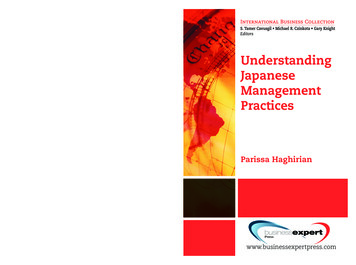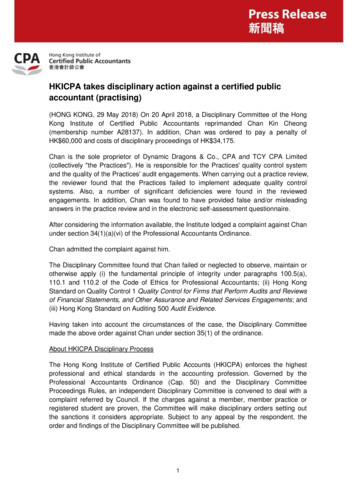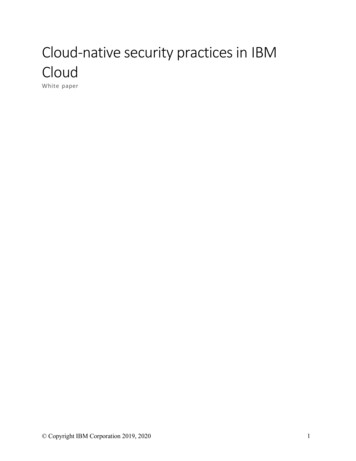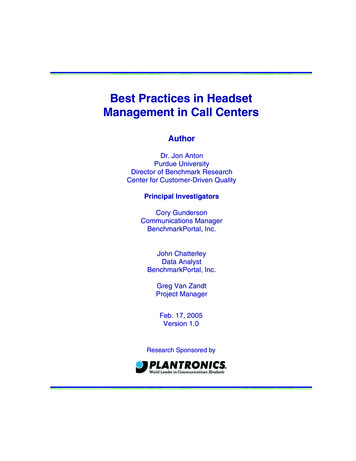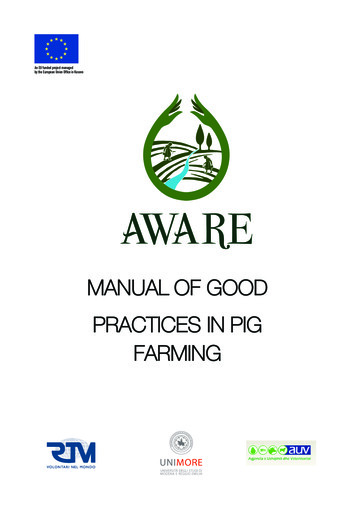
Transcription
"O &6 GVOEFE QSPKFDU NBOBHFE CZ UIF &VSPQFBO 6OJPO 0GàDF JO ,PTPWPMANUAL OF GOODPRACTICES IN PIGFARMING
Edited by: Luisa Antonella Volpelli – Professor at the University of Modena and Reggio Emilia.With contributions from Nicola Battistella - RTM Project Coordinator – and the Kosovo Veterinary Agency.Printed in Pristina, May 2017Produced by NGO Reggio Terzo Mondo
This publication has been realized with the contribution ofEuropean Union. The contents of this manual are the sole responsibility of RTM, UNIMORE and AVUK and do not reflectin any way the views of the European Union.4
TABLE OF CONTENTSIntroduction and acknowledgments7Overview of the Project A.W.A.R.E.9Management and feed of sows13Management of piglets39The stage of growth and fattening51Livestock facilities61Main pathologies75Feed summary tables795
6
INTRODUCTION AND ACKNOWLEDGMENTSThis Manual is a result of training activities deliveredbetween February 2015 and March 2016 under theA.W.A.R.E. Project – Action of Women in Agribusiness for anew Regional Economy, to farmers of EVA Cooperative and agroup of veterinarians working in the Western Region of Kosovo. As these activities were of fundamental importance fora rural development project aiming empowerment and improvement of the pork production chain in Kosovo, it was decided to address some important elements in a short, userfriendly manual, rich in practical aspects.The schematic basis of the manual therefore responds to thisneed and the willingness to produce not merely a book, but apractical and immediate support to the daily activities of medium size pig farming management.The manual is a summary of best practices of all farmers involved in the project and, at the same time, a tool for gradually introducing new techniques and reaching the standardsof pig farmers in EU member states.7
It should therefore be seen as a result of a process lastingmore than a year, but also as a starting point for the development of the pig farming sector in Kosovo.For this reason, although it has been developed within theA.W.A.R.E. Project, this text was designed with the hope thatit would become a useful tool for all operators involved inthis sector.The preparation of this manual was made possiblethanks to the generous support provided by the University ofModena and Reggio Emilia, and in particular by ProfessorLuisa Antonelli Volpelli, who has visited Kosovo several timesin order to deliver trainings and to monitor the developmentsin the Project area.The Kosovo Veterinary Agency has guaranteed continuous support and facilitated the synergies and collaborations, that have helped give density to the training.RTM would like to thank them and all other institutions andorganizations that have contributed in various ways to thedesigning of this manual.8
AWARETitle:Action of Women in Agribusiness for a new RegionalEconomyLocation:Kosovo – Western Economic RegionTotal duration:24 monthsObjectives:General objectives: contribute to EU standards compatible farming, processing and retail and marketingpractices implemented in the meat sector.Specific objectives: support the development of thecomplete chain of pork production in the WesternRegion through the valorization of cooperative production and traditional knowledge of minority ruralwomen.Expectedoutcomes:(1) Increased production capacities and managementstandards of target pig farms in the Western Region.(2) Increased pork processing capacities in the Western Region.(3) Local pork products introduced in the regionandKosovo market.(4) A regional quality brand is developed and distributed to protect and promote typical pork production9
at regional and national level.ACTIVITY CLUSTER 1 – COOPERATIVE PRODUCTIONKey activities:Implementation of a training program on management of pig farms for veterinarians and pig breedersin the cooperative.Providing technical assistance to pig breeders in thecooperative for drafting individual plans for the expansion of pig farms.Financial and technical support for pig breeders in thecooperative for the expansion of pig farms.ACTIVITY CLUSTER 2 – DEVELOPMENT OF THE PRODUCTIONConstruction and equipping of a modern small-scaleslaughterhouse for slaughtering and processing ofpigs in Klinë/Klina.Implementation of a training program for pig breeders in cooperative on pig slaughtering and processingtechniques.Study visit to Emilia Romagna Region (Italy) and observation of slaughter and pig farming techniques forpig farmers in the cooperative.Provision of technical and financial assistance to pigfarmers in the cooperative for the management ofthe plant and start of production.10
ACTIVITY CLUSTER 3 – MARKETING AND GROUPPROMOTIONImplementation of a training program on marketingand promotion of quality agricultural products forproducers, retailers and tourism enterprises.Provision of technical assistance in defining sales contracts, introducing pork and secondary products intoregional and Kosovo market.Provision of financial assistance to producers, retailers and tourism companies in the promotion of porkproducts on the market.ACTIVITY CLUSTER 4 – DEFINING A REGIONAL BRANDProvision of technical assistance in defining andadopting a Regulation on Production for Pig Farmsand Pork Processing.Designing a regional quality brand to be used for porkproducts.Designing of an information campaign to promote theregional brand.11
12
MANAGEMENT OF SOWS13
THE CULTURE OF PIG FARMINGKey objectives Improving cultivation performance: Production efficiency; Growth speed; Efficiency of changing the feed.Improving structural quality of meat.Main points Income earning for farmers: from the sale of meat,the derived products and from animals.Obtaining high quality products safe for consumerhealth.Preserving the wellbeing of animals and humans.Reducing the impact of breeding on the environment.PHASES OF THE BREEDING CYCLESow FertilizationConception (114-115 days)FarrowingNursing (21-28 days)Covered rest ( 6 days)Piglets Weaning (21-28 days, 5-7 kg of bodyweight)14
Post-weaning (up to 30 kg)Followedby Fattening of a light pigFattening of a heavy pigBreeding new sowsGrowthfattening 100kg light pig 6 months 160kg heavy pig 10 monthsA315
HEAT SIGNSIn the pro-estrus and estrus phases animals face anatomicand behavioural changes, particularly at the level of genitals,that facilitate the identification of standing heat and drawthe attention of the handler.PRO-ESTRUSPHASE ESTRUSPHASE Thickening and reddening of the vulva.The animal is not calm.The animal shows interest in humanpresence (e.g. when the handler passesby, the animal is the first to rise).Appetite begins to reduce.If the sow is free, she attempts to leanon other pigs, and if other pigs attemptthe same, she does not resist andstands still.Presence of vaginal fluid (mucus).The redness of the vulva begins to reduce.The edema of the vulva begins to reduce.The presence of the mucus is increased(it becomes increasingly bigger towardsthe end of standing heat).The sow requires a boar.It loses appetite.Makes a characteristic roar.Keeps leaning on other sows and if theydo the same she does not move.16
In the presence of the pig she standsstill, lowers and raises the ears.Accepts mating.RECOMMENDED: take the sow to the boar once the standingheat has begun and leave her there until the emergence ofthe immobility reflex.If artificial fertilization occurs, the first fertilization at thetime of the appearance of heat; then fertilization is repeatedafter 24 hours until the appearance of the reflex of immobilization.BREEDING NEW REPRODUCERS: YOUNG SOWS/GILTSThe following should be considered: It is recommended that the gilt begin the reproduction cycle as early as possible pregnant and nursing income.However, starting too early when the gilt is tooyoung may negatively affect her physical development in the future.17
Solution – When to fertilize? The beginning of her reproductive life, i.e. puberty and first ovulation, mostly occurs from 5to 8 months of age (on average about 200 days, weight 90100kg). But, it is advisable to wait and carry out the firstmating at about 7.5 to 8 months of age, when the bodyweight reaches 135 to 140 kg.LET’S HELP GILTS BEGIN The beginning of the reproduction of gilts may be supportedby a number of actions: Exposure to boar, at least 10 – 15 min/day, starting at 150 days of age.Luminated environments.Space of around 2,5 m2/head.Abundant feed, but not to excess.Give them more feed 7-10 days prior to standing heat inwhich they should be fertilized.If a gilt has never come into estrus for 8 to 9 months of life, itis better to move her to fattening, NOT to reproduction!WHAT WE SEE IN BOARSThe young boar reaches sexual maturity at about 5 to 6months of age, but due to poor seed quality it is advisableNOT to use boars before 7 to 8 months of age. Boar fertility18
increases with age and reaches its maximum between 15and 20 months of age.It is better to breed in pens with external fences faster puberty and better sexual behavior.They should be able to see other pigs they should NOTbe kept in isolated pens and in dark.It is preferable to have gilts/sows in breeding facilities. ASPECTS OF CONTROLING FERTILIZATIONFrom the next insemination to the farrowing, we shouldCONTROL: Feed.ONGOING control of recurrent standing heat: weshould realize if she is not pregnant!Ecographic control is necessary (starting with the 21stday of pregnancy).Environment control: watch for high temperatures,they might disrupt the pregnancy.The shelter should have a number of characteristics: Possibly individual feed, peace, rest. Facilitate potential recurrence of the estrus phase the passage of a boar and/or handler.19
Individual shelter facilitates feed, control, treatment ofthe animal; reduces aggression. However, if the sows/gilts have more space to move(collective pens, fences, open meadows) it will improve the psycho-physical wellbeing and reducebowel problems.Ways of sheltering sows caused a big debate in the EU (seemore).FARROWING It is preferable for the sow to fast on the day of farrowing, however WATER should be available.The farrowing pen should be the cleanest space ofthe farms: excrement is systematically removed.Heat lamps are turned on for the piglets before thefarrowing starts.Usually, sows do not require assistance, however,“cautious” monitoring may significantly reduce postpartum mortality in case of problems: “weak” farrowing (oxytocin i.m.), badly positioned piglets, weakpiglets NURSINGSows are good milk producers they produce lots of milk,containing lots of fat and protein. as long as it gets enoughfeed proper feed.20
MILK PRODUCTION Depends on the number of piglets to nurse (NOT onthe number of newborn piglets adoptions are important!).Does not depend on the body weight of sows (exception: those at first farrowing).Depends on the amount of daily feed/energy intake!DURATION OF WEANINGWeaning normally occurs between days 28 – 35. If it occurs too soon (at less than 21 days), in addition to difficulties with piglets, delays may often occur with the sow returning to estrus, whenthey could be fertilized again.If it occurs beyond day 35 there are no advantages for piglets, and the sow would continuebreastfeeding in vain.In order to disrupt the production of milk after the pigletshave been weaned, it will be sufficient to put the sow on fastfor one day, but with water available to her.BREEDINGReplacement of sows once they have completed their reproduction cycle because of age or because they have stoppedreproducing.21
BREEDING CAN BE: INTERNAL (Reproducing new sows from those farrowed in the stall): the advantage is that the animalsare known and there are no risks of the appearanceof pathologies from outside; in addition, the costs arelower.EXTERNAL (purchase of new sows): genetically bettersows can be purchased, with better reproductive potential, no blood connections; more costly.It is advisable to keep a few of the sows born in the stall, aswell as to buy some new sows from outside.When buying sows from outside, they should be of age 4-5months, and not yet mated. Purchasing pregnant sows poses a risk in terms of pathologies, however, it can be done ifthe seller is known and close.QUANTITATIVE PRODUCTION OF SOWSSow management involves high costs in terms of housingstructures and the feed they consume.The only voice of their reproduction farrowing of piglets.It should be as high as possible, this means: Increase of the number of farrowings /years.22
Increase of the number of weaned piglets for eachgroup of newborns.It is important to RECORD all events related to the reproductive life of sows.A1723
For every productive sow we should know: The average number of live farrowed piglets/farrowings (Tn).Mortality % between farrowing and weaning(Tm).I (interval between farrowings) the duration ofnursing A weaning/fertilization interval (ISF) duration of conception G.P Spro Tn * (1 – Tm) * 365IFor every present sow we should know: The interval between the entry of the sows andthe first farrowing.The interval between last weaning and recuperation.24
THE IMPROVEMENT OF THE PRODUCTIVITY OF THE SOWMEANSOn the one side, there is improvement of the parameter ; this may depend on a number offactors: Genetic, affecting the breeding and (less) thehealth of piglets.Environmental: characteristics of recuperation, amicroclimate suitable for conception and thenduring the first weeks of the life of piglets.Pathogenic: protection against diseases thatcause abortion, pre-natal embryonic mortality.Feed: the feed served to sows and piglets is animportant factor affecting the health and thegrowth of piglets.Management: assistance with farrowing whennecessary, continuous monitoring of piglets,which significantly reduce mortality.On the one side, “PERIODS OF NON-PRODUCTIVITY ARE REDUCED”, so not everything is conception and nursing. Young sows/gilts are, in such a case, very often “aweakness”. Delays between first mating and effective fertilization.25
Delays in recurrence of first estrusafter weaning, and lost conceptions. Increase of the number of fertilization/conception interventions. Loss of time and money, in the case of lack of conception, during the days from fertilization up toidentification of a failed conception (return tostanding heat, abortion/re-absorption, pseudoconception). The same goes for the intervals that follow the reform, they are usually unnecessarily extended by trying the fertilization several times.26
DEVELOPMENT OF REPRODUCTION IN BOAR STALLSOptimal levelTolerable level2,42,2Less than 8 days85%75%Less than 15 days92%82%Abortions1,0%3,0%1211Still births4,0%7,0%MORTALITY (UP TOWEANING)10%15%Average N ofweaned piglets/farrowing10,59,3Average N ofweaned piglets/sow/year2521Average N farrowings/sow/yearWeaning –fertilization interval:Average N of livefarrowed piglets perfarrowing27
FEED DURING PREGNANCY During pregnancy, because of low demand, thefeed should be rationed.Towards the end of pregnancy it is desirable toincrease the nutrition (practically up to additional1 kg of feed /day).This can be done by increasing the content of lipids colostrum and milk high fat production survival and growth of piglets.Excessive diet at conception is useless and costly( !!), causes excess fat in the sow: this then reduces her appetite and consequently her (already insufficient) capacity to swallow at thenext lactation, causing the sow to loose evenmore weight!FEED DURING PREGNANCY should be RATIONED 2-3 DAYS UPON FERTILIZATION: 2,0 kg/head is sufficient.From the FIRST to the THIRD month: 2,5 kg/head upto 3,0 kg/head.THE LAST MONTH: increase by 3,5 kg/head, gainingin fetus size, the body weight of piglets at birth andtheir vitality.By the end of the pregnancy the sow should gain inshape but not in fat: fat animal have problems at farrowing and lack of appetite at the onset of nursing.28
NOTE: The quantities of COMPLETE CONCENTRATE FEEDshould be shown. It will be seen case by case, as well aswhen using self-produced feed (corn, barley, soybean, forage, vegetable waste, bran, etc.). Be careful to avoid feed contaminated with toxins(e.g. micro toxins).Always provide sufficient water, they can drink up to18 l/day.This is a period when the sow makes the best use ofrations rich in fiber: grass, forage, bran, beet pulp, silage, vegetable waste.FEED DURING NURSINGFeed given during nursing affects milk production, and consequently piglet growth and weight loss of the sow.In practice: The sow be provided UNRESTRICTED feed, especiallyif nursing 9-10 or more piglets,It should be given feed that provides around 3300kcal ED/kg. Should gain (depending on the size, genetic type,nursing phase, environmental conditions ) from 4,5kg/d to 5,5 kg/d from week two onwards.29
It should be assessed case by case according to feed produced independently and those bought as to how to feedthe animals.If there are fewer piglets, the sow could be given less feed. Ifthere are more sows that have farrowed within few days, It ismore beneficial to have adoptions, in order to avoid toolarge a number of piglets with any of the sows.Remember that her already reduced ability to swallow is nowinsufficient and deteriorated. If she has gained too much weight (fat).If the feed provides little energy, unprocessed.If there is little water.If the environment is warm.For very productive sows, the fattening diet is recommended. Ensures higher concentration of energy in equalfeed.Desirable improvement.The sow feels less heat after feeding improvement in summer season.REVIEW OF FEED FOR SOWSGiven the very different requirements in terms of feed duringpregnancy and nursing, it is advisable to use a variety offeed in both phases:30
The nursing phase requires large quantities of feed,with more energy and protein.During pregnancy less feed is given, with less energyand protein.The following table contains information regarding: Levels of energy, protein, lysine, calcium and phosphorus advisable in feed rations for sows during bothphases.Examples of composition of whole feeds.It will be seen case by case how to use raw materials tofollow these instructions.AVERAGE NUTRITIONAL CHARACTERISTICS OF FEED FORSOWSPREGNANCYNURSINGED Kcal/kg (min-max)2800 -33003100 – 3400EN Kcal/kg (min-max)21502350Protein %13 -1415 – 1731
Lysine %0,60,9 – 1Calcium %1,10,9Phosphorus %0,50,62,5 - 34,5 - 6Quantity of feed(kg /head/day)EXAMPLES OF COMPOSITION OF WHOLE FEED FOR SOWS%PREGNANCYNURSINGGrains, beet pulp55 - 7055 - 70Bran15 - 2010 - 15Protein flour10 - 1515 - 200-12-4FatGrains: corn, barley, wheat, etc.Protein flour: soy, sunflower32
Two examples of feed that can be produced in the company:PREGNANCYNURSINGCorn flour4853Barley flour1510Bran2013Soy flour extract1520Fat-2Vitamin and mineralsupplements22%SUMMARY OF DIFERENT PHASES OF FEED FOR SOWSSOW: should have good growth/development, but shouldnot fatten.Good practice as needed up to 50-60 kg, afterwards thefeed should be rationed.DISTRIBUTION before the fertilization of sows: increase inthe quality of feed in the following 2 weeks.First part of pregnancy reduce size, up to above 2,5kg/head/day.33
If the sow loses weight as a result of previous nursing, addingfat to feed rations may be efficient for fast recovery ofweight.Always give feed rich in fibers (bran, grass, clover, ) to fightconstipation.Second and third part of pregnancy keep the nutritionallevel, the sow recuperates equally in weight and rebuilds reserves for lactation.The last part of pregnancy fetuses grow fast, diet supplements improve the weight at birth and are thus vital.In a mother, more energy favours the development of thequantity, which is a basis for the production of colostrum andthen milk.Remember: excessive fattening is counterproductive.The needs of embryos are still almost none, but be carefulwith vitamins and minerals.MANAGEMENT AND WELLBEINGThe system of sow treatment and all animal treatment ingeneral should meet their needs in all phases of the reproductive cycle.34
THE NEEDS OF THE SOWTHE NEEDS OF THE FARMER Should not be malnu- Good performance oftritioned;the animal; Should not have Reduction of labour;physical and thermal Ease in treatment;problems; Acceptablecapital Should not suffer incosts;juries or pathologies; Acceptable financial re Should not have fearturn.or stress; Should have normalbehavior.The debate around the two main ways of sheltering sowsduring the phase of conception:INDIVIDUAL SHELTER versus GROUP SHELTERGroup shelterAdvantages:Problems: Simpleconstruction, Competition among anilower fixed costs;mals, feed distribution is Freedom of movementnot equal;for the sow, healthy Difficult individual conbones;trol (e.g. therapy); Lower costs of feed dis- Hierarchy fights dangertribution.ous during the phase ofembryonic development(first 30 days).35
Individual shelterAdvantages:Problems: Weighted feed for every Lack of movement;animal; Problems with mi Reduction of feed concroclimate, cold andsumed in vain;warm; No problems with hier Winter:heatingarchy, no attacks;and/or increase in Individual control of anfeed;imals (e.g. pathologies, Problems with artreatments);thritis, difficulties at Better working condifarrowing, piglets lestions for the handlers.healthy; More difficult occurrence of estrus; Less WELLBEING ofthe sow.LAW ON THE PROTECTION OF ANIMALS ON FARMSFrom 1976, the European Union has formulated conventionsand has issued indirect directives for specific species on theprotection of animals in breeding. One important step wasthe issuing Directives CE 98/58 (indirect).36
In general: Qualified personnel assistance;Freedom of movement;Recuperation;Treatment;Control of automatic systems;Nutrition;No darkness or full illumination.MINIMAL NORMS FOR THE PROTECTIONS OF PIGSCurrently, "Minimum Standards for the Protection of Pigs"were originally set by Directive 91/630 / EC, and the application of cultivation 6 heads or 5 sows. Stabilization of minimal possible spaces. Prohibition of attacks on sows and gilts. Control of automatic installations, ventilation, fulldarkness is not allowed, adequate nutrition, at least1 time/day. More rigorous provisions by individual states.Later directives have included or partially modified previousdirectives.The European Union has issued to all Member States Directive 120/2008/EC, which is the basis for Regulation No.37
3/2015 of the Republic of Kosovo on the establishment ofminimum standards for the protection of pigs.Let’s see the main points of the directives and the so-calledRegulation: It is forbidden to use individual shelters for pregnantsows from 28 days after fertilization and 1 week before birth, including for gilts.Expanding possible spaces; the presentation of thesize and density of the animals even in the collectivestall.Cracks: minimum distance from small beams, maximum distance from cracks.Supply with exploration and manipulation material(straw, ).Provide temporary access to feed without attacks;Minimize cases of battle and assaults.Adult pigs: at least 10 m2 if the stall is also used forcouples.Indications of noise and lightning.Training of employees on topics related to wellbeing.38
MANAGEMENT OF PIGLETS39
FARROWING: FIRST CARE/STEPS TO TAKECOLOSTRUM: it is the milk produced by the breasts in thefirst 1-2 days, contains irreplaceable substances that protectpiglets from pathologies (antibodies).VERY IMPORTANT: to make sure all the piglets receive mother’s milk, because they can only absorb antibodies during thefirst 12 hours. Moreover, it is very rich in nutrients, irreplaceable for their livelihood and for protection against cold.During the first 3 – 5 days of their life they need to be in awarm environment, above 35 C place heating lamps andturn them on before the farrowing; the temperature in therest of the pen should be the most suitable for the sow, theideal is over 18-22 C.40
RECOMMENDED TEMPERATURES FOR THE WELLBEING OFTHE SOW AND THE PIGLETSPERIODIN FARROWINGFACILITYIN PIGLET AREABefore farrowing20 C----Days1 - 2 20 C34 CDays3 - 7 18 C28 CDays8 - 14 18 C26 CDays 14 - 25 18 C24 CHANDLING AFTER FARROWINGCutting off the umbilicus: it should be approximately 2 cmfrom the abdomen and immediately disinfected.Cutting off the tail: Only if there are many cases of tail bite inthe stall, the tail is trimmed to about 4 cm. Traditionally, thetails of new reproducers should NOT be cut. It is usually doneon the first day of life.41
Cutting off incisor teeth: it is not advisable nowadays, thereis greater risk of injury to young pigs; it is only done if thesow demonstrates irritation.Castration: it is a drastic but necessary step to overcome theunwanted effects of testicular function: internal meat of aboar of over 90-100kg of live weight would develop unpleasant odour.It is an unavoidable step to slaughter pigs with the highestweight, but the consequences for the farming are evident:the castrated animal reduces the potential of muscle synthesis in favour of lipid deposition, negatively affecting: The quality of the pig;The production economy.When is castration performed? At early age, within the firsttwo weeks of life.Nowadays, there are available injections that inhibit the activity of sexual hormones and alternative to castration thatwill increasingly be requested by EU.Iron injections: piglets show modest iron reserves from thebirth and nursing cannot compensate this shortage.The injection is administered in the neck and never in thelower part of the body.42
Generally, complex iron is used, with a highly absorbent anduseful composition, and usually does not cause anomalouspigmentation of meat.AFTERBIRTH WEIGHTIt is the number of litter that affects the most the weight ofgrowth and the farrowing cycle.Underweight piglets weighting under 900g or worse under 700g, even in perfect hygiene conditions in stalls, becomesubject to high mortality, or if they survive: They do not grow much and consequently thisprolongs the time necessary to achieve theweight for the market waste of money.They need more feed to grow waste of money.They will have less muscle and more fat lowquality meat.More advantageous is the elimination of badness at birth orduring weaning, forming homogeneous and "reversible" portions”.CAUSES OF MORTALITY OF PIGLETSMost of cases of piglet mortality are a consequence of kicking by the mother the pen should have certain structure43
that will protect piglets, especially when the sow stretches orrises.In addition, they should be protected from the cold, themother of the piglets should be fed quality feed, mixing withother animals should be avoided. in order to reduce mortality losses.PROBLEMS WITH WEANING – FEED“Weaning” is not only the moment of separation from themother: it involves gradual replacement of milk with solidfeed, so it is a whole phase of nursing and integrating otherfeeds . just as it is done with humans!FEED AND PRINCIPLES OF PIGLET NUTRITIONLipid: sow milk has plenty of fat, which piglets use well asthey need large amounts of energy for growth, normally 56% in the early age diet.Vegetable fat is more digestible; if we use fat animals, theyshould be of very good quality.Proteins: early age diet should be rich in high quality proteins.44
Animal proteins (skim milk and whey, fish meal flour)are the best to use.Vegetable protein (soy, grains) are less expensive andthe digestive tract adapts easily we use bothsources.We should never use big quantities of vegetable protein, they cause digestion problem.Carbohydrates Lactose is highly digestible and favors the necessarymicroflora (lactobacilli). There should always be asmall amount of digestible fibers (pulp, barn).Starch ( grains; barley is better than corn) unprocessed, separated and chopped.Keep in mind:A good ration for the initial age is costly. however, Mortality and pathologies cost a lot, too!It is used only up to 10 days after weaning, so theconsumption is very low.Second age ration (from 10 to 25-30 kg of weight): can beless expensive if the necessary attention has been paid be-45
fore!! no more milk and fish derivatives, no more chopping of feed, the piglet has now adapted.Every feed should ALWAYS be introduced gradually, by mixing feeds for a few days.FEED MANAGEMENTDURING NURSING, introduction of solid feed starts from day5-7 by a few grams, in the piglet pen; from day 10 the piglets should be placed at the feed-through, the feed is gradually increased and it is advisable to change it every day.AFTER WEANING: if the health condition is good, the feedshould be distributed as needed. If they develop diarrhea use rations.Noodle feed is recommended.THE COMPOSITION OF FEED FOR PIGLETSThe requirements vary greatly from the stage of nursing ( mother’s milk) to the next stage, therefore two kinds offeeds are advised: The first during nursing, adapted for this phase and inorder to facilitate weaning. The second to start with from 10-15 days uponweaning.46
The following indicators should be reported in the tables below: Levels of energy, proteins, lysine, calcium and phosphorus, advised for the diet of pigs in both phases. Examples of the composition of whole feeds.It will be shown case by case how to use raw foods in orderto follow these instructions.It is difficult to provide the feeds for the initial age becauseit requires row feeds.47
AVERAGE NUTRITIONAL CHARACTERISTICS OF THE FEEDFOR PIGSAge 1 Age 2 Age in days40 - 4565 - 70Weight in kg10 - 1225 - 30Soluble energyKcal/kg3300 - 36003300 - 3600Net energy Kcal/kg2250 - 25002250 - 25005,01021 - 2318,5 – 20,0Lysine %1,51,2Calcium %1
The animal is not calm. The animal shows interest in human presence (e.g. when the handler passes by, the animal is the first to rise). Appetite begins to reduce. If the sow is free, she attempts to lean on other pigs, and if other pigs attempt the same, she does not resi



